Xun Chen
Independent Researcher
Reloc-VGGT: Visual Re-localization with Geometry Grounded Transformer
Dec 26, 2025Abstract:Visual localization has traditionally been formulated as a pair-wise pose regression problem. Existing approaches mainly estimate relative poses between two images and employ a late-fusion strategy to obtain absolute pose estimates. However, the late motion average is often insufficient for effectively integrating spatial information, and its accuracy degrades in complex environments. In this paper, we present the first visual localization framework that performs multi-view spatial integration through an early-fusion mechanism, enabling robust operation in both structured and unstructured environments. Our framework is built upon the VGGT backbone, which encodes multi-view 3D geometry, and we introduce a pose tokenizer and projection module to more effectively exploit spatial relationships from multiple database views. Furthermore, we propose a novel sparse mask attention strategy that reduces computational cost by avoiding the quadratic complexity of global attention, thereby enabling real-time performance at scale. Trained on approximately eight million posed image pairs, Reloc-VGGT demonstrates strong accuracy and remarkable generalization ability. Extensive experiments across diverse public datasets consistently validate the effectiveness and efficiency of our approach, delivering high-quality camera pose estimates in real time while maintaining robustness to unseen environments. Our code and models will be publicly released upon acceptance.https://github.com/dtc111111/Reloc-VGGT.
UniPR-3D: Towards Universal Visual Place Recognition with Visual Geometry Grounded Transformer
Dec 24, 2025Abstract:Visual Place Recognition (VPR) has been traditionally formulated as a single-image retrieval task. Using multiple views offers clear advantages, yet this setting remains relatively underexplored and existing methods often struggle to generalize across diverse environments. In this work we introduce UniPR-3D, the first VPR architecture that effectively integrates information from multiple views. UniPR-3D builds on a VGGT backbone capable of encoding multi-view 3D representations, which we adapt by designing feature aggregators and fine-tune for the place recognition task. To construct our descriptor, we jointly leverage the 3D tokens and intermediate 2D tokens produced by VGGT. Based on their distinct characteristics, we design dedicated aggregation modules for 2D and 3D features, allowing our descriptor to capture fine-grained texture cues while also reasoning across viewpoints. To further enhance generalization, we incorporate both single- and multi-frame aggregation schemes, along with a variable-length sequence retrieval strategy. Our experiments show that UniPR-3D sets a new state of the art, outperforming both single- and multi-view baselines and highlighting the effectiveness of geometry-grounded tokens for VPR. Our code and models will be made publicly available on Github https://github.com/dtc111111/UniPR-3D.
EchoMark: Perceptual Acoustic Environment Transfer with Watermark-Embedded Room Impulse Response
Nov 09, 2025Abstract:Acoustic Environment Matching (AEM) is the task of transferring clean audio into a target acoustic environment, enabling engaging applications such as audio dubbing and auditory immersive virtual reality (VR). Recovering similar room impulse response (RIR) directly from reverberant speech offers more accessible and flexible AEM solution. However, this capability also introduces vulnerabilities of arbitrary ``relocation" if misused by malicious user, such as facilitating advanced voice spoofing attacks or undermining the authenticity of recorded evidence. To address this issue, we propose EchoMark, the first deep learning-based AEM framework that generates perceptually similar RIRs with embedded watermark. Our design tackle the challenges posed by variable RIR characteristics, such as different durations and energy decays, by operating in the latent domain. By jointly optimizing the model with a perceptual loss for RIR reconstruction and a loss for watermark detection, EchoMark achieves both high-quality environment transfer and reliable watermark recovery. Experiments on diverse datasets validate that EchoMark achieves room acoustic parameter matching performance comparable to FiNS, the state-of-the-art RIR estimator. Furthermore, a high Mean Opinion Score (MOS) of 4.22 out of 5, watermark detection accuracy exceeding 99\%, and bit error rates (BER) below 0.3\% collectively demonstrate the effectiveness of EchoMark in preserving perceptual quality while ensuring reliable watermark embedding.
Explore Data Left Behind in Reinforcement Learning for Reasoning Language Models
Nov 06, 2025Abstract:Reinforcement Learning with Verifiable Rewards (RLVR) has emerged as an effective approach for improving the reasoning abilities of large language models (LLMs). The Group Relative Policy Optimization (GRPO) family has demonstrated strong performance in training LLMs with RLVR. However, as models train longer and scale larger, more training prompts become residual prompts, those with zero variance rewards that provide no training signal. Consequently, fewer prompts contribute to training, reducing diversity and hindering effectiveness. To fully exploit these residual prompts, we propose the Explore Residual Prompts in Policy Optimization (ERPO) framework, which encourages exploration on residual prompts and reactivates their training signals. ERPO maintains a history tracker for each prompt and adaptively increases the sampling temperature for residual prompts that previously produced all correct responses. This encourages the model to generate more diverse reasoning traces, introducing incorrect responses that revive training signals. Empirical results on the Qwen2.5 series demonstrate that ERPO consistently surpasses strong baselines across multiple mathematical reasoning benchmarks.
UniLGL: Learning Uniform Place Recognition for FOV-limited/Panoramic LiDAR Global Localization
Jul 16, 2025Abstract:Existing LGL methods typically consider only partial information (e.g., geometric features) from LiDAR observations or are designed for homogeneous LiDAR sensors, overlooking the uniformity in LGL. In this work, a uniform LGL method is proposed, termed UniLGL, which simultaneously achieves spatial and material uniformity, as well as sensor-type uniformity. The key idea of the proposed method is to encode the complete point cloud, which contains both geometric and material information, into a pair of BEV images (i.e., a spatial BEV image and an intensity BEV image). An end-to-end multi-BEV fusion network is designed to extract uniform features, equipping UniLGL with spatial and material uniformity. To ensure robust LGL across heterogeneous LiDAR sensors, a viewpoint invariance hypothesis is introduced, which replaces the conventional translation equivariance assumption commonly used in existing LPR networks and supervises UniLGL to achieve sensor-type uniformity in both global descriptors and local feature representations. Finally, based on the mapping between local features on the 2D BEV image and the point cloud, a robust global pose estimator is derived that determines the global minimum of the global pose on SE(3) without requiring additional registration. To validate the effectiveness of the proposed uniform LGL, extensive benchmarks are conducted in real-world environments, and the results show that the proposed UniLGL is demonstratively competitive compared to other State-of-the-Art LGL methods. Furthermore, UniLGL has been deployed on diverse platforms, including full-size trucks and agile Micro Aerial Vehicles (MAVs), to enable high-precision localization and mapping as well as multi-MAV collaborative exploration in port and forest environments, demonstrating the applicability of UniLGL in industrial and field scenarios.
SpeechVerifier: Robust Acoustic Fingerprint against Tampering Attacks via Watermarking
May 28, 2025Abstract:With the surge of social media, maliciously tampered public speeches, especially those from influential figures, have seriously affected social stability and public trust. Existing speech tampering detection methods remain insufficient: they either rely on external reference data or fail to be both sensitive to attacks and robust to benign operations, such as compression and resampling. To tackle these challenges, we introduce SpeechVerifer to proactively verify speech integrity using only the published speech itself, i.e., without requiring any external references. Inspired by audio fingerprinting and watermarking, SpeechVerifier can (i) effectively detect tampering attacks, (ii) be robust to benign operations and (iii) verify the integrity only based on published speeches. Briefly, SpeechVerifier utilizes multiscale feature extraction to capture speech features across different temporal resolutions. Then, it employs contrastive learning to generate fingerprints that can detect modifications at varying granularities. These fingerprints are designed to be robust to benign operations, but exhibit significant changes when malicious tampering occurs. To enable speech verification in a self-contained manner, the generated fingerprints are then embedded into the speech signal by segment-wise watermarking. Without external references, SpeechVerifier can retrieve the fingerprint from the published audio and check it with the embedded watermark to verify the integrity of the speech. Extensive experimental results demonstrate that the proposed SpeechVerifier is effective in detecting tampering attacks and robust to benign operations.
MobiVital: Self-supervised Time-series Quality Estimation for Contactless Respiration Monitoring Using UWB Radar
Mar 14, 2025Abstract:Respiration waveforms are increasingly recognized as important biomarkers, offering insights beyond simple respiration rates, such as detecting breathing irregularities for disease diagnosis or monitoring breath patterns to guide rehabilitation training. Previous works in wireless respiration monitoring have primarily focused on estimating respiration rate, where the breath waveforms are often generated as a by-product. As a result, issues such as waveform deformation and inversion have largely been overlooked, reducing the signal's utility for applications requiring breathing waveforms. To address this problem, we present a novel approach, MobiVital, that improves the quality of respiration waveforms obtained from ultra-wideband (UWB) radar data. MobiVital combines a self-supervised autoregressive model for breathing waveform extraction with a biology-informed algorithm to detect and correct waveform inversions. To encourage reproducible research efforts for developing wireless vital signal monitoring systems, we also release a 12-person, 24-hour UWB radar vital signal dataset, with time-synchronized ground truth obtained from wearable sensors. Our results show that the respiration waveforms produced by our system exhibit a 7-34% increase in fidelity to the ground truth compared to the baselines and can benefit downstream tasks such as respiration rate estimation.
SpecHub: Provable Acceleration to Multi-Draft Speculative Decoding
Nov 08, 2024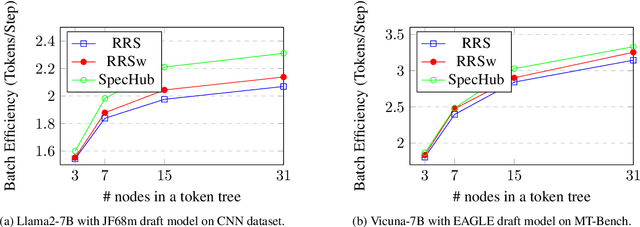
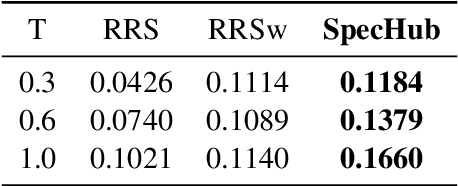
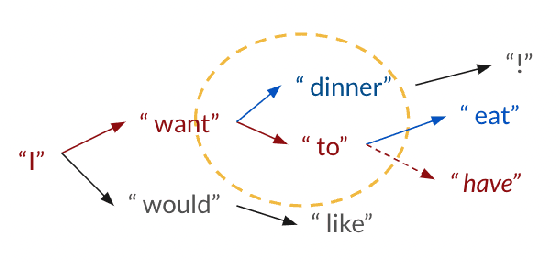
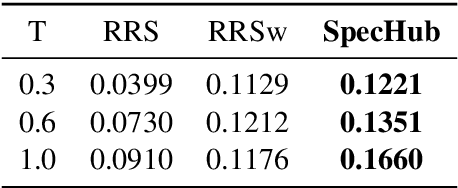
Abstract:Large Language Models (LLMs) have become essential in advancing natural language processing (NLP) tasks, but their sequential token generation limits inference speed. Multi-Draft Speculative Decoding (MDSD) offers a promising solution by using a smaller draft model to generate multiple token sequences, which the target LLM verifies in parallel. However, current heuristic approaches, such as Recursive Rejection Sampling (RRS), suffer from low acceptance rates in subsequent drafts, limiting the advantages of using multiple drafts. Meanwhile, Optimal Transport with Membership Cost (OTM) can theoretically improve acceptance rates, but its computational cost is too high for real-time use. We present SpecHub, a novel, efficient sampling-verification method for MDSD that improves acceptance rates with only linear computational overhead. By simplifying the OTM problem into a compact Linear Programming model, SpecHub significantly reduces computational complexity. It further accelerates sampling by leveraging a sparse joint distribution, focusing computation on high-probability token sequences. In extensive experiments, Spechub consistently generates 0.05-0.27 and 0.02-0.16 more tokens per step than RRS and RRS without replacement. We attach our code at \url{https://github.com/MasterGodzilla/Speculative_decoding_OT}.
BadRAG: Identifying Vulnerabilities in Retrieval Augmented Generation of Large Language Models
Jun 03, 2024



Abstract:Large Language Models (LLMs) are constrained by outdated information and a tendency to generate incorrect data, commonly referred to as "hallucinations." Retrieval-Augmented Generation (RAG) addresses these limitations by combining the strengths of retrieval-based methods and generative models. This approach involves retrieving relevant information from a large, up-to-date dataset and using it to enhance the generation process, leading to more accurate and contextually appropriate responses. Despite its benefits, RAG introduces a new attack surface for LLMs, particularly because RAG databases are often sourced from public data, such as the web. In this paper, we propose \TrojRAG{} to identify the vulnerabilities and attacks on retrieval parts (RAG database) and their indirect attacks on generative parts (LLMs). Specifically, we identify that poisoning several customized content passages could achieve a retrieval backdoor, where the retrieval works well for clean queries but always returns customized poisoned adversarial queries. Triggers and poisoned passages can be highly customized to implement various attacks. For example, a trigger could be a semantic group like "The Republican Party, Donald Trump, etc." Adversarial passages can be tailored to different contents, not only linked to the triggers but also used to indirectly attack generative LLMs without modifying them. These attacks can include denial-of-service attacks on RAG and semantic steering attacks on LLM generations conditioned by the triggers. Our experiments demonstrate that by just poisoning 10 adversarial passages can induce 98.2\% success rate to retrieve the adversarial passages. Then, these passages can increase the reject ratio of RAG-based GPT-4 from 0.01\% to 74.6\% or increase the rate of negative responses from 0.22\% to 72\% for targeted queries.
InternLM2 Technical Report
Mar 26, 2024
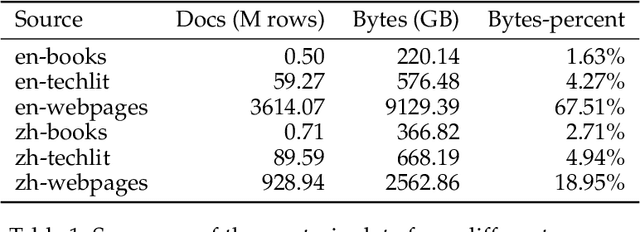
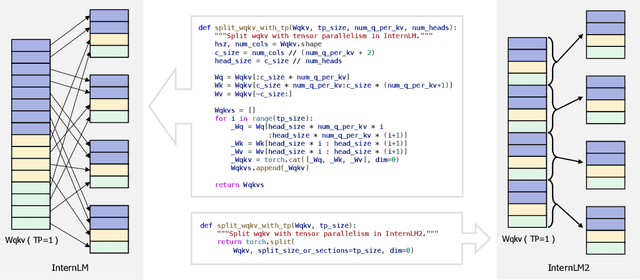

Abstract:The evolution of Large Language Models (LLMs) like ChatGPT and GPT-4 has sparked discussions on the advent of Artificial General Intelligence (AGI). However, replicating such advancements in open-source models has been challenging. This paper introduces InternLM2, an open-source LLM that outperforms its predecessors in comprehensive evaluations across 6 dimensions and 30 benchmarks, long-context modeling, and open-ended subjective evaluations through innovative pre-training and optimization techniques. The pre-training process of InternLM2 is meticulously detailed, highlighting the preparation of diverse data types including text, code, and long-context data. InternLM2 efficiently captures long-term dependencies, initially trained on 4k tokens before advancing to 32k tokens in pre-training and fine-tuning stages, exhibiting remarkable performance on the 200k ``Needle-in-a-Haystack" test. InternLM2 is further aligned using Supervised Fine-Tuning (SFT) and a novel Conditional Online Reinforcement Learning from Human Feedback (COOL RLHF) strategy that addresses conflicting human preferences and reward hacking. By releasing InternLM2 models in different training stages and model sizes, we provide the community with insights into the model's evolution.
 Add to Chrome
Add to Chrome Add to Firefox
Add to Firefox Add to Edge
Add to Edge